Related Research Articles

Hazardous waste is waste that has substantial or potential threats to public health or the environment. Hazardous waste is a type of dangerous goods. They usually have one or more of the following hazardous traits: ignitability, reactivity, corrosivity, toxicity. Listed hazardous wastes are materials specifically listed by regulatory authorities as hazardous wastes which are from non-specific sources, specific sources, or discarded chemical products. Hazardous wastes may be found in different physical states such as gaseous, liquids, or solids. A hazardous waste is a special type of waste because it cannot be disposed of by common means like other by-products of our everyday lives. Depending on the physical state of the waste, treatment and solidification processes might be required.
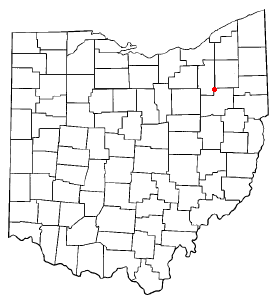
Uniontown is a census-designated place (CDP) in Stark County, Ohio, United States. The population was 7,173 at the 2020 census.
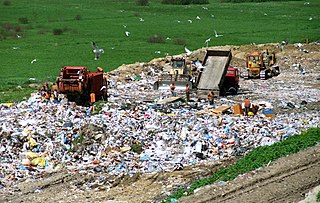
A landfill site, also known as a tip, dump, rubbish dump, garbage dump, or dumping ground, is a site for the disposal of waste materials. Landfill is the oldest and most common form of waste disposal, although the systematic burial of the waste with daily, intermediate and final covers only began in the 1940s. In the past, refuse was simply left in piles or thrown into pits; in archeology this is known as a midden.

The Resource Conservation and Recovery Act (RCRA), enacted in 1976, is the principal federal law in the United States governing the disposal of solid waste and hazardous waste.
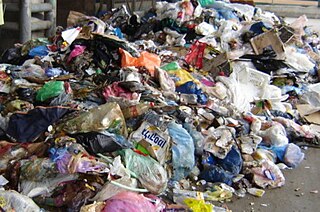
Municipal solid waste (MSW), commonly known as trash or garbage in the United States and rubbish in Britain, is a waste type consisting of everyday items that are discarded by the public. "Garbage" can also refer specifically to food waste, as in a garbage disposal; the two are sometimes collected separately. In the European Union, the semantic definition is 'mixed municipal waste,' given waste code 20 03 01 in the European Waste Catalog. Although the waste may originate from a number of sources that has nothing to do with a municipality, the traditional role of municipalities in collecting and managing these kinds of waste have produced the particular etymology 'municipal.'
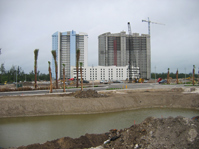
Munisport Landfill is a closed landfill located in North Miami, Florida adjacent to a low-income community, a regional campus of Florida International University, Oleta River State Park, and estuarine Biscayne Bay.
Diamond Alkali Company was an American chemical company incorporated in 1910 in West Virginia by a group of glass industry businessmen from Pittsburgh. The company soon established a large chemical plant at Fairport Harbor, Ohio, which would operate for over sixty years. In 1947, the headquarters of the company was moved from Pittsburgh to Cleveland. Later the company established a plant in Redwood City, California, that produced ion-exchange resins. In 1967, Diamond Alkali and Shamrock Oil and Gas merged to form the Diamond Shamrock Corporation. Diamond Shamrock would go on to merge with Ultramar Corporation, and the combined company, Ultramar Diamond Shamrock Corporation, would in turn be acquired by Valero Energy Corporation in 2001.

Raybestos is a brand of automotive brakes established in 1902 by Arthur H. Raymond and Arthur F. Law of Bridgeport, Connecticut.

Wade Dump was a rubber recycling facility and illegal industrial waste storage and disposal facility in Chester, Pennsylvania. It was located at 1 Flower Street on the western bank of the Delaware River just north of the Commodore Barry Bridge.
The former Operating Industries Inc. Landfill is a Superfund site located in Monterey Park, California at 900 N Potrero Grande Drive. From 1948 to 1984, the landfill accepted 30 million tons of solid municipal waste and 300 million US gallons (1,100,000 m3) of liquid chemicals. Accumulating over time, the chemical waste polluted the air, leached into groundwater, and posed a fire hazard, spurring severely critical public health complaints. Recognizing OII Landfill's heavy pollution, EPA placed the financial responsibility of the dump's clean-up on the main waste-contributing companies, winning hundreds of millions of dollars in settlements for the protection of human health and the environment.
Solid waste policy in the United States is aimed at developing and implementing proper mechanisms to effectively manage solid waste. For solid waste policy to be effective, inputs should come from stakeholders, including citizens, businesses, community-based organizations, non-governmental organizations, government agencies, universities, and other research organizations. These inputs form the basis of policy frameworks that influence solid waste management decisions. In the United States, the Environmental Protection Agency (EPA) regulates household, industrial, manufacturing, and commercial solid and hazardous wastes under the 1976 Resource Conservation and Recovery Act (RCRA). Effective solid waste management is a cooperative effort involving federal, state, regional, and local entities. Thus, the RCRA's Solid Waste program section D encourages the environmental departments of each state to develop comprehensive plans to manage nonhazardous industrial and municipal solid waste.
Halaco Engineering Co. operated a scrap metal recycling facility at 6200 Perkins Road, Oxnard, Ventura County, California from 1965 to 2004. The state placed the facility on the California Hazardous Waste Priority List in 2007. The facility includes a smelter area west and the Waste Management Unit (WMU) east of the Oxnard Industrial Drain (OID). Attention was brought to the Halaco site through illegal waste disposal without permits. Further investigation yielded a discovery of harmful contaminants. Remediation of surrounding contaminated areas including the wetlands was completed in 2007. Restoration of the wetlands and management of the WMU are ongoing.
The Casmalia Resources Hazardous Waste Landfill was a 252–acre disposal facility located in the hills near Casmalia, California. During its operation, 4.5 billion pounds of hazardous waste from up to 10,000 individuals, businesses and government agencies were dumped on site. The facility was closed in 1989, and is now a listed as a Superfund Site by the Environmental Protection Agency.
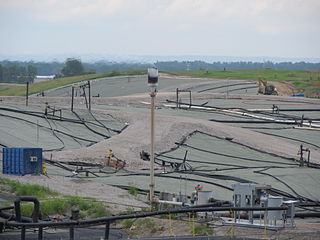
West Lake Landfill is a closed, unlined mixed-waste landfill located in Bridgeton, Missouri. It was featured in the 2015 documentaries The First Secret City, The Safe Side of the Fence and the 2017 HBO documentary Atomic Homefront. Its contents have been shown to include radioactive waste; it is thus also an EPA Superfund cleanup site.
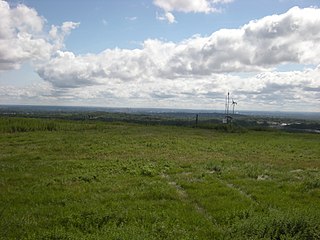
The Central Landfill is a 154-acre (62 ha) waste disposal site in Johnston, Rhode Island. It is the state's only landfill and receives more than 90% of the state's solid waste. It has been on the Environmental Protection Agency's Superfund National Priorities List since 1986. The site is owned and operated by the Rhode Island Resource Recovery Corporation (RIRRC).
Emmell's Septic Landfill (ESL) is located at 128 Zurich Ave, Galloway Township, New Jersey and takes up about 38 acres of space. The landfill was in operation from 1967 until 1979. ESL disposed of liquid and solid waste including many chemicals such as volatile organic compounds (VOCs), Polychlorinated Biphenyls (PCBs), Trichloroethene and Vinyl chloride which all had their own effect on the environment and community. These chemicals affected the groundwater required millions of dollars to reconstruct the groundwater pathways and provide clean water to residents. The landfill holds a Hazardous Ranking Score of a 50/100, qualifying for the Superfund National Priority List. In August 1999, the state acknowledged the site's contamination and held town meetings and provided research upon the site such as groundwater samples. In July 1997, a sitewide investigation was called upon by the United States Environmental Protection Agency. In total the clean up was estimated to cost $5 million to fund this superfund site, and a grant of $3.9 million was given by the Federal Government under the Recovery Act Funding (Previti). Today, the project is still ongoing however, greatly improved since the landfill was discovered.
Forest Waste Products is a 120-acre (49-hectare) Superfund site in Forest Township northwest of Otisville, Michigan.
Michigan Disposal Service, also known as Kalamazoo City Dump, Kalamazoo City Landfill, Dispose-O-Waste and the Cork Street Landfill, is a 68-acre Superfund site in Kalamazoo, Michigan. Davis Creek is adjacent to the site. It is one of six Superfund sites in the Kalamazoo River watershed.
Guam v. United States, 593 U.S. ___ (2021), was a U.S. Supreme Court case dealing with a dispute on fiscal responsibility for environmental and hazardous cleanup of the Ordot Dump created by the United States Navy on the island of Guam in the 1940s, which Guam then ran after becoming a territory in 1950 until the landfill's closure in 2011. The Supreme Court ruled unanimously that under the Comprehensive Environmental Response, Compensation, and Liability Act of 1980, Guam had filed its lawsuit to recover a portion of cleanup costs for the landfill from the United States government in a timely manner, allowing their case to proceed.
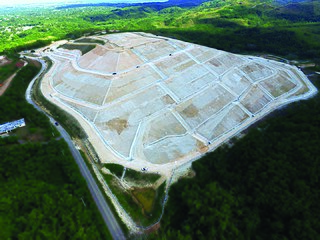
Ordot Dump, also known as Ordot Landfill, was a landfill on the western Pacific island of Guam that operated from the 1940s until 2011. Originally operated by the U.S. military, ownership was transferred to the Government of Guam in 1950, though it continued to receive all waste on the island, including from Naval Base Guam and Andersen Air Force Base, through the 1970s.
References
- 1 2 3 "Evaluation of Solid Waste Baling and Balefills: Volumes I and II". nepis.epa.gov. 1975. Retrieved 2 August 2020.
- ↑ Deborah Grant Lord; William W. Beck, Jr. (August 1982). "Environmental Impacts of Special Types of Landfills". nepis.epa.gov. Retrieved 2 August 2020.
- ↑ "Closure/Post Closure Plan, Dickson County Landfill/Balefill, Dickson County, Tennessee | Freedom of Information Act (FOIA) | US EPA". 19january2017snapshot.epa.gov. February 1997. Retrieved 2 August 2020.
- ↑ "Air Pollution Control Title V Permit to Operate Statement of Basis for Title V Permit, No. V-SV-00001-2010.00" (PDF). 19january2017snapshot.epa.gov. Retrieved 2 August 2020.
- ↑ Courtney Flatt (27 October 2017). "Underground Fire Returns To A One-Time Landfill In Eastern Washington". Oregon Public Broadcasting . Retrieved 2 August 2020.
- ↑ Washington State Department of Ecology. 2017 https://fortress.wa.gov/ecy/gsp/DocViewer.ashx?did=63998 . Retrieved 2 August 2020.
{{cite web}}: Missing or empty|title=(help) - ↑ Washington State Department of Ecology https://fortress.wa.gov/ecy/gsp/DocViewer.ashx?did=56973 . Retrieved 2 August 2020.
{{cite web}}: Missing or empty|title=(help) - ↑ "Site Information". apps.ecology.wa.gov. Retrieved 2 August 2020.
- ↑ "PASCO SANITARY LANDFILL | Superfund Site Profile | Superfund Site Information | US EPA". cumulis.epa.gov. Retrieved 2 August 2020.
- 1 2 3 "RI DEM/RIRRC, Comprehensive Solid Waste Management Planning Working Group- Solid Waste Balefills Information" (PDF). dem.ri.gov. Retrieved 2 August 2020.
- ↑ Higgins, Michael (14 January 2001). "RULING DOESN'T BURY DEBATE OVER BALEFILL". chicagotribune.com. Retrieved 2 August 2020.
- ↑ Gregory, Ted (26 July 1994). "AGENCY WILL CONTINUE THE BATTLE TO BUILD A BALEFILL NEAR BARTLETT". chicagotribune.com. Retrieved 2 August 2020.
- ↑ Swanson, Stevenson (17 January 1990). "BALEFILL CLOSE TO BECOMING A REALITY AFTER COUNTY BOARD'S OK". chicagotribune.com. Retrieved 2 August 2020.
- ↑ "Northwest Cook County Balefill | Miscellaneous Documents | Archive | Uncategorised". swancc.org. Retrieved 2 August 2020.
- ↑ "Reclamation Center Lost Belongings". visitmonmouth.com. Retrieved 2 August 2020.
- ↑ "County of Monmouth New Jersey Series 2015 bonds" (PDF). co.monmouth.nj.us. p. 8. Retrieved 2 August 2020.
- ↑ "Methane gas collection to begin again at 1-E Landfill". North Jersey Media Group. 29 September 2016. Retrieved 2 August 2020.
- ↑ "BERGEN COUNTY BALER FACILITY". clui.org. Retrieved 2 August 2020.
- ↑ "HMDC SOLID WASTE BALER FACILITY". clui.org. Retrieved 2 August 2020.
- ↑ Robert E. Hughey (4 May 1983). "Department of Envirnmental Protection: Certification of Approval" (PDF). nj.gov. Retrieved 2 August 2020.
- ↑ Iver Peterson (5 May 1995). "What a Dump!; Landfills Yield Riches As Fields of Natural Gas". The New York Times . Retrieved 2 August 2020.
- ↑ "Landfill". casperwy.gov. Retrieved 2 August 2020.
- ↑ "Reconstructed Casper Balefill Building Opens Monday". K2 Radio. 16 November 2019. Retrieved 2 August 2020.
- ↑ Arno Rosenfeld (7 May 2017). "Solution finally emerges in landfill saga". Casper Star-Tribune Online. Retrieved 2 August 2020.
- ↑ "The Lauritzen Gardens Project: Preserving a Sensitive Area with a 585-Foot Single Drive at Depths Reaching 50 Feet" (PDF). no-digpipe.com. 2014. Retrieved 2 August 2020.
- ↑ Michael Kelly (8 October 2014). "Kelly: Lauritzen Gardens' $20M conservatory another 'amazing icon' for Omaha". Omaha.com. Retrieved 2 August 2020.
- ↑ "Zender Environmental" (PDF). zendergroup.org. 2003. Retrieved 2 August 2020.
- ↑ "Solid Waste | Residents". colchester.ca. Retrieved 2 August 2020.
- ↑ Courtney Edgar (24 July 2018). "The low-down on Iqaluit's new $35M landfill | Nunatsiaq News". Nunatsiaq News. Retrieved 2 August 2020.
